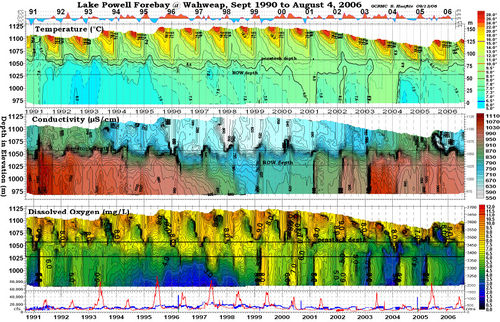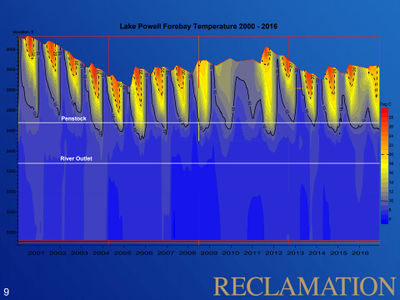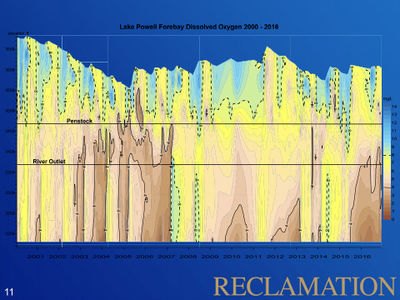Difference between revisions of "WATER QUALITY"
From Glen Canyon Dam AMP
Cellsworth (Talk | contribs) |
Cellsworth (Talk | contribs) |
||
| (53 intermediate revisions by the same user not shown) | |||
| Line 17: | Line 17: | ||
</table> | </table> | ||
| − | [[file:ForebayWaterQuality.jpg ]] | + | [[file:ForebayWaterQuality.jpg|thumb|center|500px ]] |
<!-- | <!-- | ||
| Line 47: | Line 47: | ||
|style="color:#000;"| | |style="color:#000;"| | ||
| − | + | [[File:ForebayTemp 2000 2016.jpg|thumb|center|400px|Forebay temperature 2000-2016 [https://www.usbr.gov/uc/progact/amp/twg/2017-01-26-twg-meeting/AR4_Radtke.pdf https://www.usbr.gov/uc/progact/amp/twg/2017-01-26-twg-meeting/AR4_Radtke.pdf] ]] | |
| + | [[File:ForebayDO 2000 2016.jpg|thumb|center|400px|Forebay dissolved oxygen 2000-2016 [https://www.usbr.gov/uc/progact/amp/twg/2017-01-26-twg-meeting/AR4_Radtke.pdf https://www.usbr.gov/uc/progact/amp/twg/2017-01-26-twg-meeting/AR4_Radtke.pdf] ]] | ||
| − | + | ===WQ field parameters measured monthly at forebay and quarterly throughout reservoir=== | |
| + | *Depth | ||
| + | *Temperature | ||
| + | *Dissolved Oxygen | ||
| + | *pH | ||
| + | *Conductivity / TDS | ||
| + | *ORP | ||
| + | *Turbidity | ||
| + | *Chl a | ||
| + | *Secchi Depth | ||
| + | *Meteorological Information | ||
| − | + | ===WQ samples sent for lab analysis=== | |
| − | + | *Major ions | |
| − | + | *pH | |
| − | + | *Conductivity | |
| − | + | *TDS, roe & soc | |
| − | + | *TSS | |
| − | + | *Alkalinity | |
| + | *DOC | ||
| + | *OP | ||
| + | *TP | ||
| + | *NH3-N | ||
| + | *NO3+NO2-N | ||
| + | *TN | ||
| + | *Chl | ||
| + | *Phytoplankton / Zooplankton | ||
| + | *Metals (once per year, UT) | ||
|} | |} | ||
| Line 67: | Line 87: | ||
|class="MainPageBG" style="width:45%; border:1px solid #cedff2; background:#f5faff; vertical-align:top;"| | |class="MainPageBG" style="width:45%; border:1px solid #cedff2; background:#f5faff; vertical-align:top;"| | ||
{| width="100%" cellpadding="2" cellspacing="5" style="vertical-align:top; background:#f5faff;" | {| width="100%" cellpadding="2" cellspacing="5" style="vertical-align:top; background:#f5faff;" | ||
| + | ! <h2 style="margin:0; background:#cedff2; font-size:120%; font-weight:bold; border:1px solid #a3b0bf; text-align:left; color:#000; padding:0.2em 0.4em;">Links and Information </h2> | ||
| + | |- | ||
| + | |style="color:#000;"| | ||
| + | |||
| + | *[http://gcdamp.com/index.php?title=Portal:GCDAMP_Knowlege_Assessments GCMRC Annual Reports page] | ||
| + | *[http://gcdamp.com/index.php?title=Nutrients Nutrients Page] | ||
| + | *[http://gcdamp.com/index.php?title=TEMPERATURE Temperature Page] | ||
| + | |||
| + | |- | ||
| + | ! <h2 style="margin:0; background:#cedff2; font-size:120%; font-weight:bold; border:1px solid #a3b0bf; text-align:left; color:#000; padding:0.2em 0.4em;"> Water Quality PEP Reviews </h2> | ||
| + | |- | ||
| + | |style="color:#000;"| | ||
| + | |||
| + | *[http://gcdamp.com/index.php?title=2017_Water_Quality_PEP 2017 Water Quality PEP] | ||
| + | *[[Media:Jones 2001 Final report PEP GCMRC IWQP.pdf| Final report of the 2001 Protocol Evaluation Panel for the Grand Canyon Monitoring and Research Center Integrated Water Quality Program (IWQP)]] | ||
| + | |||
| + | |- | ||
! <h2 style="margin:0; background:#cedff2; font-size:120%; font-weight:bold; border:1px solid #a3b0bf; text-align:left; color:#000; padding:0.2em 0.4em;">Water Quality Gages</h2> | ! <h2 style="margin:0; background:#cedff2; font-size:120%; font-weight:bold; border:1px solid #a3b0bf; text-align:left; color:#000; padding:0.2em 0.4em;">Water Quality Gages</h2> | ||
|- | |- | ||
|style="color:#000;"| | |style="color:#000;"| | ||
| + | *[https://tableau.usgs.gov/views/colorado-river-water-quality-gcd/GlenCanyonDamSiteHourlyAverages?%3Aembed=y&%3AisGuestRedirectFromVizportal=y Glen Canyon Dam Site: Hourly Averages] | ||
| + | *[https://www.gcmrc.gov/discharge_qw_sediment/station/GCDAMP/09379901 Glen Canyon Dam near Page, AZ] | ||
*[http://www.gcmrc.gov/discharge_qw_sediment/station/GCDAMP/09380000 Colorado River at Lees Ferry] | *[http://www.gcmrc.gov/discharge_qw_sediment/station/GCDAMP/09380000 Colorado River at Lees Ferry] | ||
| − | *[http://www.gcmrc.gov/discharge_qw_sediment/station/GCDAMP/09383050 Colorado River | + | *[http://www.gcmrc.gov/discharge_qw_sediment/station/GCDAMP/09383050 Colorado River near river mile 30] |
| − | *[http://www.gcmrc.gov/discharge_qw_sediment/station/GCDAMP/09383100 Colorado River above | + | *[http://www.gcmrc.gov/discharge_qw_sediment/station/GCDAMP/09383100 Colorado River above Little Colorado River near Desert View, AZ] |
| − | *[ | + | *[https://www.gcmrc.gov/discharge_qw_sediment/station/GCDAMP/09402500 Colorado River near Grand Canyon, AZ] |
| − | *[http://www.gcmrc.gov/discharge_qw_sediment/station/GCDAMP/09404120 Colorado River | + | *[http://www.gcmrc.gov/discharge_qw_sediment/station/GCDAMP/09404120 Colorado River above National Canyon near Supai, AZ] |
| − | *[http://www.gcmrc.gov/discharge_qw_sediment/station/GCDAMP/09404200 Colorado River | + | *[http://www.gcmrc.gov/discharge_qw_sediment/station/GCDAMP/09404200 Colorado River above Diamond Creek near Peach Springs, AZ] |
|- | |- | ||
| Line 82: | Line 121: | ||
|- | |- | ||
|style="color:#000;"| | |style="color:#000;"| | ||
| + | |||
| + | '''2023''' | ||
| + | *[https://www.usbr.gov/uc/progact/amp/twg/2023-11-08-twg-meeting/20231108-WaterQualityConditionsLakePowell-508-UCRO.pdf Water Quality Conditions in Lake Powell and below Glen Canyon Dam] | ||
| + | *[https://www.usbr.gov/uc/progact/amp/twg/2023-11-08-twg-meeting/20231108-BasinHydrologyOperationsWaterQuality-508-UCRO.pdf Basin Hydrology, Operations and Water Quality] | ||
| + | *[https://www.usbr.gov/uc/progact/amp/twg/2023-11-08-twg-meeting/20231108-GlenCanyonDamAirInjectionTestingSeptember2023-508-UCRO.pdf Glen Canyon Dam Air Injection Testing September 2023] | ||
| + | *[https://www.usbr.gov/uc/progact/amp/amwg/2023-08-17-amwg-meeting/20230817-EffectsLowDissolvedOxygenHighTemperatureTroutFishery-508-UCRO.pdf Effects of Low Dissolved Oxygen and High Temperature on the Trout Fishery] | ||
| + | *[https://www.usbr.gov/uc/progact/amp/twg/2023-06-15-twg-meeting/20230615-BasinHydrologyOperationsWaterQuality-508-UCRO.pdf Basin Hydrology, Operations, and Water Quality] | ||
| + | *[https://www.usbr.gov/uc/progact/amp/twg/2023-01-26-twg-meeting/20230126-AnnualReportingMeeting-PredictingWaterQualityLakePowell-508-UCRO.pdf Predicting Water Quality in Lake Powell: Updates and Improvements to the Existing Mechanistic Model ] | ||
| + | *[https://www.usbr.gov/uc/progact/amp/twg/2023-01-26-twg-meeting/20230126-AnnualReportingMeeting-DissolvedOxygenDynamicsLakePowellGlenCanyonTailwater-508-UCRO.pdf Dissolved Oxygen Dynamics in Lake Powell and in the Glen Canyon Tailwater] | ||
| + | |||
| + | '''2022''' | ||
| + | *[https://www.usbr.gov/uc/progact/amp/twg/2022-10-13-twg-meeting/20221013-WaterQualitySynthesisUpdate-508-UCRO.pdf Water Quality Synthesis Update ] | ||
| + | *[https://www.usbr.gov/uc/progact/amp/twg/2022-10-13-twg-meeting/20221013-BasinHydrologyOperationsWaterQuality-508-UCRO.pdf Basin Hydrology, Operations and Water Quality ] | ||
| + | *[https://www.usbr.gov/uc/progact/amp/twg/2022-10-13-twg-meeting/20221013-LowDissolvedOxygenReleasesCurrentState-of-Practice-TechnicalReport-UCRO.pdf Low Dissolved Oxygen in Releases: Current State-of-Practice - Technical Report No. ENV-2022-61 ] | ||
| + | *[https://www.usbr.gov/uc/progact/amp/amwg/2022-08-18-amwg-meeting/20220818-DissolvedOxygenState-of-PracticeStudy-508-UCRO.pdf Dissolved Oxygen State-of-Practice Study ] | ||
| + | *[https://www.usbr.gov/uc/progact/amp/amwg/2022-08-18-amwg-meeting/20220818-BasinHydrologyOperationsWaterQuality-508-UCRO.pdf Basin Hydrology, Operations and Water Quality ] | ||
| + | *[https://www.usbr.gov/uc/progact/amp/twg/2022-06-16-twg-meeting/20220616-BasinHydrologyOperationsWaterQuality-508-UCRO.pdf Basin Hydrology, Operations and Water Quality ] | ||
| + | *[https://www.usbr.gov/uc/progact/amp/amwg/2022-02-10-amwg-meeting/20220210-BasinHydrologyWaterQualityOperations-508-UCRO.pdf Basin Hydrology, Water Quality, and Operations ] | ||
| + | *[https://www.usbr.gov/uc/progact/amp/twg/2022-04-13-twg-meeting/20220413-BasinHydrologyOperationsWaterQuality-Presentation-508-UCRO.pdf Basin Hydrology, Operations, and Water Quality ] | ||
| + | *[https://www.usbr.gov/uc/progact/amp/twg/2022-04-13-twg-meeting/20220413-LakePowellWaterQualityMarch2021-March2022-508-UCRO.pdf Lake Powell Water Quality March 2021-March 2022 ] | ||
| + | |||
| + | '''2021''' | ||
| + | *[https://www.usbr.gov/uc/progact/amp/twg/2021-10-14-twg-meeting/20211014-UpdateGlenCanyonDamLakePowellDissolvedOxygenState-of-PracticeProject-Presentation-508-UCRO.pdf Update on the Glen Canyon Dam/Lake Powell Dissolved Oxygen State-of-Practice Project] | ||
| + | |||
| + | '''2020''' | ||
| + | *[https://www.usbr.gov/uc/progact/amp/twg/2020-06-24-twg-meeting/20200624-MetalimnionLowDissolvedOxygenEventsLakePowell-508-UCRO.pdf Metalimnion low dissolved oxygen events in Lake Powell and their transport downstream of Glen Canyon Dam ] | ||
| + | *[https://doi.org/10.1002/lno.11399 Deemer et al., 2020, Calcite precipitation in Lake Powell reduces alkalinity and total salt loading to the Lower Colorado River Basin: Limnology and Oceanography ] | ||
| + | *[https://www.usbr.gov/uc/progact/amp/twg/2020-01-13-twg-meeting/20200113-AnnualReportingMeeting-DissolvedOxygenDownstreamGlenCanyonDam2019-Presentation-508-UCRO.pdf Dissolved Oxygen Downstream of Glen Canyon Dam, 2019 ] | ||
| + | *[https://www.usbr.gov/uc/progact/amp/twg/2020-01-13-twg-meeting/20200113-AnnualReportingMeeting-LakePowellRegulatorDownstreamWaterQualityEcosystemProductivity-Presentation-508-UCRO.pdf Lake Powell as a Regulator of Downstream Water Quality and Ecosystem Productivity ] | ||
| + | |||
| + | '''2018''' | ||
| + | *[https://www.usbr.gov/uc/progact/amp/twg/2018-10-10-twg-meeting/Attach_05.pdf Lake Powell Water Quality Program PPT] | ||
| + | *[https://www.usbr.gov/uc/progact/amp/amwg/2018-08-22-amwg-meeting/Attach_12.pdf GCMRC Science Updates PPT] | ||
| + | *[http://www.bioone.org/doi/10.1674/0003-0031-180.1.119 Stone et al., 2018, Abiotic Controls of Invasive Nonnative Fishes in the Little Colorado River, Arizona. The American Midland Naturalist] | ||
'''2017''' | '''2017''' | ||
| + | *[http://dx.doi.org/10.1002/lom3.10204 Payn et al., 2017, A coupled metabolic-hydraulic model and calibration scheme for estimating of whole-river metabolism during dynamic flow conditions: Limnology and Oceanography: Methods, v.15, no.10, p. 847-866] | ||
*[http://dx.doi.org/10.1002/lno.10726 Bernhardt et al. 2017. The metabolic regimes of flowing waters: Limnology and Oceanography] | *[http://dx.doi.org/10.1002/lno.10726 Bernhardt et al. 2017. The metabolic regimes of flowing waters: Limnology and Oceanography] | ||
| − | *[https://www.usbr.gov/uc/ | + | *[https://www.usbr.gov/uc/progact/amp/twg/2017-01-26-twg-meeting/AR4_Radtke.pdf Water Quality in Lake Powell and Its Influence on the Colorado River Below Glen Canyon Dam PPT] |
'''2016''' | '''2016''' | ||
*[http://pubs.usgs.gov/fs/2016/3053/fs20163053.pdf Voichick et al. 2016. Water clarity of the Colorado River—Implications for food webs and fish communities: U.S. Geological Survey Fact Sheet 2016–3053, 4 p.] | *[http://pubs.usgs.gov/fs/2016/3053/fs20163053.pdf Voichick et al. 2016. Water clarity of the Colorado River—Implications for food webs and fish communities: U.S. Geological Survey Fact Sheet 2016–3053, 4 p.] | ||
| − | *[https://www.usbr.gov/uc/ | + | *[https://www.usbr.gov/uc/progact/amp/twg/2016-02-26-twg-meeting/AR01_Topping.pdf Project 2: Streamflow, Water Quality, Sediment Transport, and Sand Budgets in the Colorado River Ecosystem] |
'''2015''' | '''2015''' | ||
*[https://pubs.usgs.gov/ds/471/pdf/ds471.pdf Historical Physical and Chemical Data for Water in Lake Powell and from Glen Canyon Dam Releases, Utah-Arizona, 1964–2013] | *[https://pubs.usgs.gov/ds/471/pdf/ds471.pdf Historical Physical and Chemical Data for Water in Lake Powell and from Glen Canyon Dam Releases, Utah-Arizona, 1964–2013] | ||
| − | *[ | + | *[https://www.usbr.gov/uc/progact/amp/twg/2015-04-21-twg-meeting/Attach_07.pdf Water Quality in Lake Mead and Upstream Influences: Dissolved Oxygen during 2014] |
| − | *[ | + | *[https://www.usbr.gov/uc/progact/amp/twg/2015-01-20-twg-meeting/Attach_01.pdf Streamflow, Water Quality, and Sediment Transport in the Colorado River Ecosystem] |
| − | *[ | + | *[https://www.usbr.gov/uc/progact/amp/twg/2015-01-20-twg-meeting/Attach_16.pdf Glen Canyon Physical Environment Update – Water Quality, Tributary Influences & Channel Analyses & Flows] |
'''2014''' | '''2014''' | ||
| Line 106: | Line 180: | ||
'''2010''' | '''2010''' | ||
*[http://crc.nv.gov/files.php/news/462536e751a496f28b512c3a16167f88/CRC-News-2010-04-24 Effects of Drought on Water Quality of Lake Powell and Glen Canyon Dam Releases] | *[http://crc.nv.gov/files.php/news/462536e751a496f28b512c3a16167f88/CRC-News-2010-04-24 Effects of Drought on Water Quality of Lake Powell and Glen Canyon Dam Releases] | ||
| − | *[https://www.usbr.gov/uc/ | + | *[https://www.usbr.gov/uc/progact/amp/twg/2010-11-15-twg-meeting/Attach_11d.pdf Update on Water Quality and 2010 Sand Input ] |
| + | |||
| + | '''2009''' | ||
| + | *[https://www.usbr.gov/uc/progact/amp/amwg/2009-04-29-amwg-meeting/Attach_03a.pdf Grand Canyon Monitoring and Research Center (GCMRC) Update] | ||
| + | *[https://www.usbr.gov/uc/progact/amp/amwg/2009-04-29-amwg-meeting/Attach_03d.pdf Water Quality and Sediment, 2008 High Flow Experiment, and Integrated Flow, Temperature, and Sediment Modeling PPT] | ||
| + | *[https://www.usbr.gov/uc/progact/amp/twg/2009-03-16-twg-meeting/Attach_11.pdf Final Report of the Protocol Evaluation Panel for the GCMRC Integrated Water Quality Program] | ||
'''2006''' | '''2006''' | ||
| − | *[https://www.usbr.gov/uc/ | + | *[https://www.usbr.gov/uc/progact/amp/twg/2006-11-08-twg-meeting/Attach_06.pdf Update on Water Quality of Lake Powell and Glen Canyon Dam Releases] |
'''2005''' | '''2005''' | ||
| Line 128: | Line 207: | ||
==Adding power generation to the bypass tubes== | ==Adding power generation to the bypass tubes== | ||
| − | Allows for drawing water from deeper in Lake Powell | + | Allows for drawing water from deeper in Lake Powell where colder and more oxygenated water may be present. |
*[[Media:Generation at Outlet Glen Canyon Dam Plan of Study CRSP Power Peaking Capacity (March 1981).pdf|Generation at Outlet Glen Canyon Dam Plan of Study CRSP Power Peaking Capacity (March 1981)]] | *[[Media:Generation at Outlet Glen Canyon Dam Plan of Study CRSP Power Peaking Capacity (March 1981).pdf|Generation at Outlet Glen Canyon Dam Plan of Study CRSP Power Peaking Capacity (March 1981)]] | ||
| + | |||
| + | ==Other methods:== | ||
| + | *Forebay diffusers | ||
| + | *Side stream super-saturation | ||
| + | *Aeration | ||
| + | *Turbine venting | ||
| + | *Surface water pumps (impellers) | ||
| + | [http://www.mobleyengineering.com/technologies/hydropowerenhancements.html (Mobley Engineering: Hydropower Enhancement Technologies)] | ||
|- | |- | ||
| Line 135: | Line 222: | ||
|- | |- | ||
|style="color:#000;"| | |style="color:#000;"| | ||
| − | |||
|} | |} | ||
Latest revision as of 16:39, 18 January 2024
|
|
Desired Future Condition for Water QualityWater quality with regards to dissolved oxygen, nutrient concentrations and cycling, turbidity, temperature, etc., is sufficient to support natural ecosystem functions, visitor safety and visitor experience to the extent feasible and consistent with the life history requirements of focal aquatic species. |
| --- |
--- |
--- |
|---|


